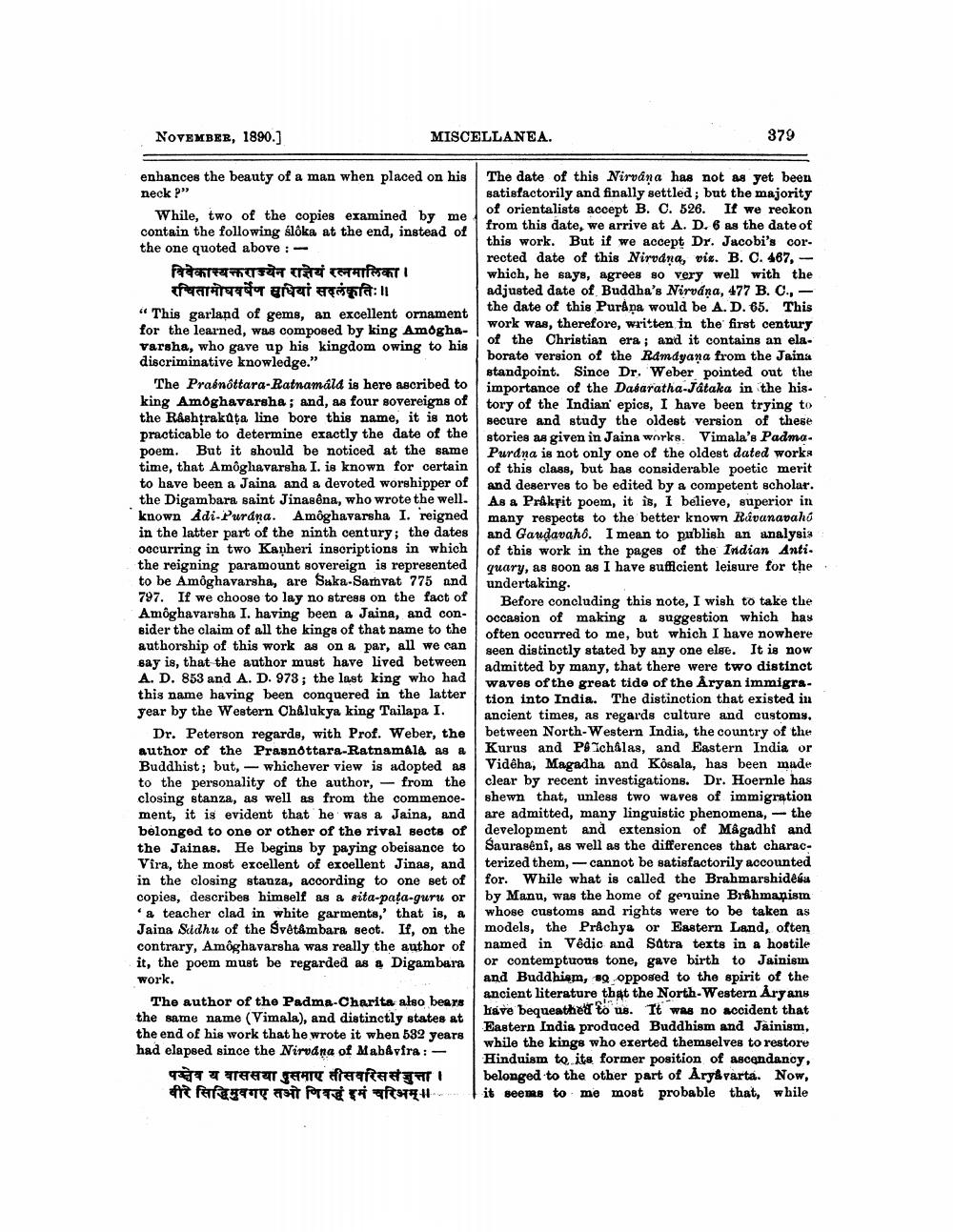________________
NOVEMBER, 1890.]
MISCELLANEA.
379
enhances the beauty of a man when placed on his The date of this Nirvana has not as yet been neck P"
satisfactorily and finally settled; but the majority While, two of the copies examined by me
of orientalists accept B. C. 526. If we reckon contain the following slôka at the end, instead of
from this date, we arrive at A. D. 6 as the date of the one quoted above :
this work. But if we accept Dr. Jacobi's cor
rected date of this Nirudna, vis. B. 0. 487,विवेकास्यक्तराज्येन राज्ञेयं रत्नमालिका।
which, he says, agrees so very well with the रचितामोघवर्षेण मुधियां सदलंकृतिः॥
adjusted date of Buddha's Nirvana, 477 B. C., - "This garland of gems, an excellent ornament
the date of this Purána would be A. D. 65. This for the learned, was composed by king Amogha
work was, therefore, written in the first century Varsha, who gave up his kingdom owing to his
of the Christian era ; and it contains an eladiscriminative knowledge."
borate version of the Ramayana from the Jains
standpoint. Since Dr, Weber pointed out the The Prabnóttara-Ratnamáld is here ascribed to
importance of the Dasaratha-Jataka in the his. king Amoghavarsha; and, as four sovereigns of
tory of the Indian epics, I have been trying to the Rashtrakata line bore this name, it is not
secure and study the oldest version of these practicable to determine exactly the date of the
stories as given in Jaina works. Vimala's Padma. poem. But it should be noticed at the same
Purdna is not only one of the oldest dated works time, that Amoghavarsha I. is known for certain
of this class, but bas considerable poetic merit to have been a Jaina and a devoted worshipper of and deserves to be edited by a competent scholar. the Digambara saint Jinasena, who wrote the well. As a Pråkfit poem, it is, I believe, superior in known Adi Purana. Amoghavarsha 1. reigned many respects to the better known Rivanavahu in the latter part of the ninth century; the dates and Gaudavaho. I mean to publish an analysis occurring in two Kayheri inscriptions in which of this work in the pages of the Indian Anti. the reigning paramount sovereign is represented quary, as soon as I have sufficient leisure for the to be Amoghavarsha, are Suka-Samvat 775 and
undertaking. 797. If we choose to lay no stress on the fact of
Before concluding this note, I wish to take the Amoghavarsha I. having been a Jaina, and con- l occasion of making a suggestion which has sider the claim of all the kings of that name to the
often occurred to me, but which I have nowhere authorship of this work as on a par, all we can
geen distinctly stated by any one else. It is now Bay is, that the author must have lived between
admitted by many, that there were two distinct A. D. 853 and A. D. 973; the last king who had
waves of the great tide of the Aryan immigrathis name having been conquered in the latter
tion into India. The distinction that existed in year by the Western Châlukya king Tailapa I.
ancient times, as regards culture and customs, Dr. Peterson regarde, with Prof. Weber, the between North-Western India, the country of the author of the Prasnottara-Ratnamala as a Kurus and P8 Ichålas, and Eastern India or Buddhist; but, whichever view is adopted as Vidêha, Magadha and Kosala, has been made to the personality of the author, - from the clear by recent investigations. Dr. Hoernle has closing stanza, as well as from the commence- shewn that, unless two waves of immigration ment, it is evident that he was a Jaina, and are admitted, many linguistic phenomena, - the belonged to one or other of the rival sects of development and extension of Mågadhi and the Jainas. He begins by paying obeisance to Saurasenf, as well as the differences that charac. Vira, the most excellent of excellent Jinas, and terized them, - cannot be satisfactorily accounted in the closing stanza, according to one set of for. While what is called the Brahmarshidesa copies, describes himself as a sita-paţa-guru or by Manu, was the home of genuine Brahmapism
& teacher clad in white garments,' that is, & whose customs and rights were to be taken as Jaina Sudhu of the Svētâmbara seot. If, on the models, the Prachya or Eastern Land, often contrary, Amôghavarsha was really the author of named in Vedic and Satra texts in a hostile it, the poem must be regarded as a Digambara or contemptuous tone, gave birth to Jainism work.
and Buddhism, 8 opposed to the spirit of the The author of the Padma Charita also bears
ancient literature that the North-Western Aryans
have bequeathed to us. It was no accident that the same name (Vimala), and distinctly states at
Eastern India produced Buddhism and Jainism, the end of his work that he wrote it when 582 years had elapsed since the Nirvana of MabAvfra: -
while the kings who exerted themselves to restore
Hinduism to its former position of ascendancy, TOT E UTATV rata
belonged to the other part of Aryavarta. Now, TTT mit Pr a ts
it seems to me most probable that, while




